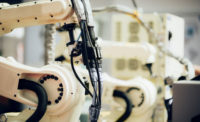Real-time connectivity
Using IIoT-enabled devices to protect individual workers and your entire facility

Photo credit: Industrial Scientific
Industrial operations, no matter how big or small, are complex and involve a variety of equipment, technology, and bespoke processes. And despite how unique your company’s process may be, they still need to comply with industry regulations and ensure the safety of your employees. You can easily achieve this with devices and equipment compatible with the Industrial Internet of Things (IIoT).
In its simplest form, IIoT-enabled equipment connects machines and devices in industrial environments to a cloud network that can provide additional data and real-time insight to improve operational processes, reduce downtime, and enhance worker safety. Furthermore, because they use a cloud network, IIoT-enabled products can be monitored from any device with an internet connection, such as a phone or tablet.
IIoT systems contain three primary components:
- Hardware: A product or device that collects data points and sends that information to the cloud.
- Connectivity: Data from connected devices is generally transferred from hardware to the cloud using wi-fi, cellular, satellite, Ethernet, or mesh network connectivity. Newer IIoT systems can transfer data from wirelessly-connected hardware directly to the cloud. For some IIoT systems, a gateway serves as an intermediate step between hardware and the cloud.
- Software: A software platform that displays the live data collected from the hardware and leverages that data to simplify pains and automate your workflows.
IIoT is everywhere you look
While IIoT technologies can be used for many applications, it’s prevalent across a variety of gas detection and safety-based applications including, but not limited to, in-plant operations, confined spaces, lone workers, hazmat response, and fence line and perimeter monitoring.
In a standard IIoT-connected gas detection program, employees wear a personal gas detector that sends real-time data – including device usage stats, location, man-down alarms, and much more – to the cloud, where safety monitoring personnel can analyze comprehensive overviews in real time. Because of this, monitoring personnel can make quick, informed decisions based on analytics to enhance safety for both the individual and the entire facility.
IIot for the individual user
At the core of nearly every personal gas detection device, the user is gaining insight into what’s happening around them and what they’re being exposed to. However, IIoT-enabled gas detectors have a lot more functionality. Immediate man-down alarms, for example, can be sent to any safety monitoring center throughout the globe with satellite connectivity so that you can receive alarms no matter how remote its location.
Live monitoring software can also improve user safety by ensuring monitoring centers know exactly where workers are located, what gas hazards they face, and whether they’ve exceeded exposure limits.
In confined space work, meanwhile, IIoT-enabled gas detectors not only sample the atmosphere in a space prior to entry, but also provide users with real-time visibility into the gases and levels that could harm them while working. These devices also have peer-to-peer connectivity options, which enable workers outside the confined space to understand exactly what’s happening inside of the space. In some cases, these monitors can send data to the cloud so remote team members can understand the environment and any safety concerns in real time.
IIoT for the entire facility
The safety of everyone at your facility is important, but so is the safety of those in your neighboring community. In industrial operations, having multiple IIoT-enabled area gas monitors in use should be part of any standard gas detection program.
In most instances, an area monitor is used to monitor a process or an area in an environment where no one is actively working. These areas often need to be under constant surveillance for gas leaks. By adding an IIoT-connected device, however, you can view real-time gas readings from any internet-connected device.
Additionally, within the facility, teams can connect personal and area gas monitors to each other via a mesh network to monitoring software to promote better collaboration and decision-making amongst the team during gas hazard emergencies.
In fence line and perimeter monitoring applications, meanwhile, it is important to make sure no toxic or combustible gases are leaving the facility and entering the community. Here, facilities place area monitors along the perimeter and connect them to live monitoring software to continuously monitor for gas leaks, receive automatic alerts when alarms go off, and more, allowing teams to take corrective action as soon as possible.
With the addition of dynamic plume modeling software, users can also take real-time data from area gas monitors and pair it with weather data to predict the path of a gas leak and identify potentially impacted areas.
For gas detection, having a fleet of equipment that is connected through IIoT is crucial in ensuring the safety of your employees both in the field and on site, as well as the safety of your local community. By staying continuously connected, you can gain enhanced visibility into your processes that can improve worker safety, improve operational processes, and reduce downtime.
Looking for a reprint of this article?
From high-res PDFs to custom plaques, order your copy today!






